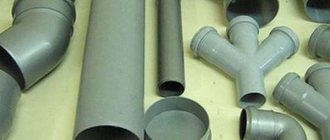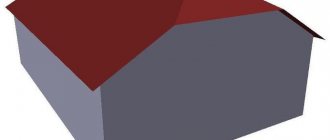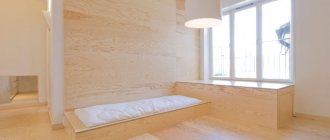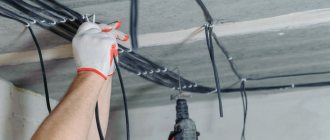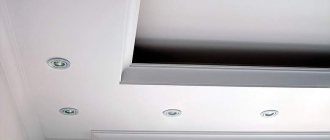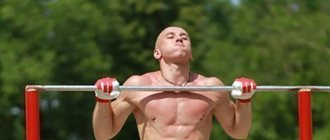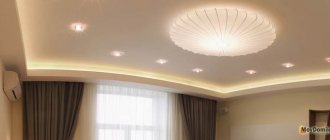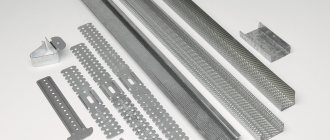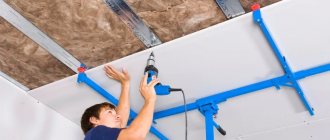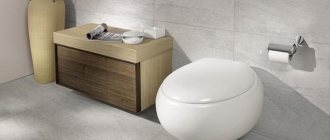Drywall is a universal building material that is in great demand. With its help, the easiest way to create partitions in a house or to level the walls in an apartment. It is easy and convenient to work with, which is why it is often chosen by craftsmen during repairs to perform the work listed above. However, the material also has its own characteristics. One of them is its rather low strength, and therefore it is not so easy to hang anything on walls made of this material. But still possible. How to hang a cabinet on a plasterboard wall? Let's figure out how to solve this problem.
How to hang a cabinet on a plasterboard wall
What to do if you need to hang a kitchen on drywall that has already been finished
In an ideal world, everything is prepared in advance, builders know where and how the kitchen furniture will be located, and based on this they make embedments for drywall at the stage of wall installation. The mortgage is a block whose dimensions exactly correspond to the distance from the load-bearing wall to the plasterboard partition; it is located in the pier and attached to the main wall as securely as possible, in order to subsequently serve, in turn, as a support for installing furniture.
How to glue or attach a mirror to drywall?
However, not everyone knows what to do if you need to hang a kitchen on drywall that has already been finished, but for some reason there were no embeds in it. There is a way to make embeds in drywall (1), which has already been finished; we will talk about it later, since it is quite expensive and is used only if it is not possible to secure it in a more accessible way, namely with the help of anchors.
Fastening furniture with anchors is done as follows:
- Using a drywall crown, a hole is cut out at the site of future fastening;
- Using a perforator, a channel is made in the main wall, up to 10 cm deep, and a steel dowel is inserted into it;
- A steel anchor with a diameter of at least 8 millimeters is attached to the dowel. Using a smaller diameter is impossible, since it will not support the large weight of furniture structures;
- The part of the wall cut out with a crown is returned to its place and sealed with putty.
The main thing to remember is that this method, although quite simple to implement, is not suitable for structures in which the distance from the main wall to the plasterboard exceeds 6 centimeters.
For heavy products, you can always make embedding bars at the stage of wall installation or after
The need to use mortgages
There are several ways out of this situation. The most reasonable solution is to plan the approximate location of the kitchen furniture at the beginning of the renovation. In this case, when installing the supporting structure perpendicular to the profile, you will need to install bars, which in the future will become the place where kitchen cabinets will be hung on plasterboard.
To protect wooden mortgages from condensation and subsequently from the appearance of fungus, they are pre-treated with special means and primed.
- After this, the frame can be covered with plasterboard, marking the installation locations of the mortgages with a marker.
In order to hang the cabinets, all that remains is to secure the awnings to the laid timber.
However, often an apartment is purchased with renovations already completed, and the new owners may receive an unpleasant gift from the old owners in the form of plasterboard walls, which they were not even warned about. People are faced with a dilemma: to make new renovations in the room or to abandon wall cabinets forever. In this situation, you can do without radical measures.
Method 5. Anchoring into a solid wall
This solution is used for main walls covered with plasterboard; it is not suitable for partitions made of gypsum plasterboard. Anchoring into the wall allows you to hang large structures, household appliances and cabinets on a plasterboard sheet.
To do this, hatch holes are cut into the gypsum board so that you can drill into the main wall with a hammer drill and install anchors. The anchor consists of a metal or plastic dowel and a long threaded screw or hook. I don’t take into account chemical dowels, because... they are used quite rarely and have some difficulties in installation.
You can hang heavy furniture on anchors if the distance from the main wall to the gypsum board does not exceed 5 cm. At a greater distance, even a thick screw that can withstand significant loads will bend over time. In this case, you can use a combined method, for example, by securing the tire to anchors and adding several attachment points to the gypsum board.
After installing the anchors, the cut sections of drywall are mounted in place. The joints and the hole around the anchor head are sealed with putty.
Anchoring is effective if the main wall is made of concrete or brick without voids. In cinder block or foam concrete, the anchor holds much worse.
You can increase reliability by passing the anchor through the rack profile of the plasterboard lining. Unfortunately, the places where furniture is attached do not always coincide with the location of the metal frame parts.
The disadvantage of mounting on anchors is the need for very precise markings. Possible distortions and deviations will become noticeable only when the furniture is already secured to the anchors, and it will not be possible to hang the cabinet “a little higher” or move it to the side.
Are Americans the only ones who don't follow instructions?
“The chests of drawers are only being recalled in the US and Canada. In other markets where IKEA furniture is sold, and there are more than 40 of them, this furniture is not being recalled, including Russia,” an IKEA representative in Russia told bbcrussian.
According to him, the furniture is no different from what is sold in the United States. A mandatory safety requirement is to secure the furniture to the wall; special brackets are included in the kit.
“The company is recalling chests of drawers in the United States because the company may want to understand why American customers are not following the instructions, which is leading to such unfortunate incidents. “No such cases have been registered in Russia or other countries except the United States,” the Russian division emphasized.
Plasterboard shelves
Shelves are a functional detail of any interior
If you know how to make plasterboard shelves with your own hands, but are unsure of your knowledge of installation methods, it is better to use a “Molly” type mount made of metal. These fasteners come in different types and designs, with hooks, screws and nuts, and caps at the end. Choose those that open on four sides.
Fasteners should be selected in accordance with the thickness of the base. Then a hole of the required size is drilled in the drywall. Using special mounting pliers, the dowel is inserted into the previously prepared hole. After this, the screw is screwed in using a screwdriver or screwdriver.
Making a shelf
For this you will need:
- construction level-rail;
- construction knife;
- screwdriver;
- “Molly” or “butterfly” fastenings;
- profile 50×25 mm;
- slats;
- frames;
- traverses;
- pencil;
- plumb line;
- sandpaper;
- electric plane;
- putty knife;
- roulette;
- rule;
- wire cutters;
- pliers;
- Molly installation tool;
- hammer;
- putty grater, electric or manual;
- respirator;
- gloves;
- protective glasses;
- bucket;
- metal scissors or grinder.
Assembly instructions:
- Develop the design of the future shelf, determine its dimensions.
- According to the drawing, attach the profiles to the wall.
- Make a frame that is strengthened with traverses and frames.
- Embroider the sheets of drywall, cutting the pieces to the required size. (see also the article Do-it-yourself drywall finishing: installation instructions).
- After this, the shelves must be plastered outside and inside, painted or covered with decorative plasters. (see also the article Finishing putty for drywall - all the main points).
Shelves are an indispensable attribute
Installation of decorative shelves and paintings
Heavier objects should be hung using special fastening devices.
Up to 10 kilograms
With such a load on the plasterboard surface, the ideal solution would be to use a “butterfly”. This option is a dowel consisting of a plastic sleeve with two spread legs on a rod and a threaded screw.
The product is attached according to the following diagram:
Based on the size of the sleeve, a suitable drill bit for a screwdriver or drill is selected. Mounting points are outlined. The tool attachment is directed strictly perpendicularly. The resulting hole should be smooth, without deformation of the edges
To prevent such damage, you need to correctly set the power of the drill. The legs of the plastic element are straightened, and the sleeve is carefully inserted. It is not recommended to press hard, as the gypsum board may be damaged. To completely sink the product, a hammer is used, since there are two protrusions at the neck that fix the position of the part. The screw is screwed in
Due to this, on the reverse side the paws rest against the sheet.
After installing all the mounting points, you can hang a picture or mirror.
To use a standard butterfly mount in a plasterboard wall, you need to drill a hole with a diameter of 8 mm
Up to 30 kilograms
It is recommended to fasten massive objects that create a load of up to 25–30 kg per fixation point using a special dowel - Driva. Its structure is similar to the previous version, but the plastic element has a “snail” shape. The part is equipped with a sharp tip and thread located on the surface of the body. A special screw is used for fixation.
Fastening a shelf or other item is carried out according to the following algorithm:
- Installation points are marked and holes with a diameter of 6 mm are drilled. It is taken into account that the seat must be exactly perpendicular to the surface.
- After preparation, you need to screw on the plastic elements. This will require some effort, because the snail thread cuts into the structure. A screwdriver will make the process much easier. The neck of the dowel should be almost in the same plane with the wall.
- Depending on the fastening device of the item being hung, installation occurs by installing and tightening the screw.
Driva fastener installation diagram
It is taken into account that Driva is divided into categories: for plasterboard bases, plastic options are recommended, since metal ones do not provide reliable installation into such a surface.
Attaching a light shelf
Let's start looking at the impact of loads on plasterboard materials by attaching lightweight shelves that do not have a big impact on the structure of the plasterboard. To attach such shelves, it is enough to use screws. How does the mounting itself on a plasterboard wall take place? We will analyze it step by step, and then we will understand the principles of such fastening, its pros and cons. This fastening is also suitable for attaching hooks to drywall, for example, for towels in the bathroom, the main thing is not to hang heavy jackets on them.
Fastening
First of all, you should select the screws. In particular, it is advisable to carry out fastenings using dowels, thus the structure will be much better and more durable. The store will help you choose the right screws or dowels, telling you about all their properties, what load they can withstand, etc. Why will this method be much better and more durable? During installation into the wall, the dowel opens up, placing emphasis on the walls of the hole, which prevents it from being easily removed from the structure.
- We make holes in the structure for installing dowels;
- We install dowels into the wall;
- Using screws, we mount hooks or brackets for the future shelf;
- We hang the shelf on the prepared place.
The mounting method is quite simple.
Advantages and disadvantages
Now it would be worth noting the pros and cons of such fastening. Let's start unconventionally, with the bad:
- First, of course, this method will not withstand heavy loads (except for fastening to the structure profile);
- It is undesirable to use it with large shelf areas, even with low weight.
And now a little about the good stuff:
- Its installation will require quite a bit of time;
- Thanks to the use of dowels, it is quite durable as long as the shelf is used properly.
Mounting rail
If you don’t want to spoil the appearance of the wall, then the mounting issue can be solved using a mounting rail. Of course, such a wall will not withstand a heavy load, but it will be possible to attach small cabinets or shelves.
This method is mainly suitable for walls with plasterboard frame fastening. You need to take the butterfly dowels and secure the mounting rail with them. In places where the profile is located, it is necessary to use self-tapping screws. The distance between fastening elements should not exceed 10–15 cm.
Preparatory stage or how to hang a cabinet on drywall
Consider the physical parameters of the cabinet: overall dimensions, weight, material from which installation will be made.
Preparation rules:
- Complete all construction work, level the walls with plasterboard, take into account all electrical installation nuances. Carefully consider and install all sockets and switches. Be sure to think about how all household appliances will be connected to the electrical network. It often happens that the presence of switches on the wall greatly interferes with the installation of furniture. Or it is not possible to use this or that technology because there is no connection to the network. Remember that alteration and dismantling not only take a lot of time, but also significantly damage all structures.
- Complete the decor of the room. The walls must be prepared in advance. Design elements must be completed so that neither wallpaper glue nor paint interfere with installation work.
Let's consider the issue of cabinet installation in more detail.
Types and methods of fastening cabinets to plasterboard
Despite the fact that the plasterboard has gypsum inside, it is very loose and relatively soft. Simple methods using self-tapping screws will not allow you to securely attach the cabinet to it. It will require the use of special methods to achieve the desired result.
There are several ways to hang cabinets.
Ways to hang a cabinet on a plasterboard wall:
Mortgage beam
The “mortgage beam” method involves attaching wooden blocks to the supposed locations of kitchen cabinets before covering the walls. During subsequent installation, the load will be evenly distributed over the surface and the gypsum board sheet will easily withstand it. The timber in this case acts as a reliable base, which is firmly fixed to the wall being mounted.
Embedded elements are pre-installed into a wall or partition made of plasterboard.
The method is one of the most reliable options, as it can withstand a load of more than 80-110 kilograms. Using it, you don’t have to worry that over time the fasteners will become loose and the cabinets will move. The block is taken 8-10 centimeters wide. The thickness is selected according to the height of the profiles.
Use expert tips to complete the work.
The work is performed according to the following algorithm:
- The distance between the vertical profiles must be measured. In accordance with the obtained dimensions, sections of bars are sawed.
- The height of the preliminary hanging of the cabinet and the location of the bar are marked on the wall. They are placed between each VP.
- The timber sections are attached to selected places at 1-4 points.
- Afterwards, the distance from the floor to the center line of the beam is measured. (the cabinets are then hung using this value).
- After the sheathing, the cabinets are installed.
Horizontal bus
With this method, the question will no longer arise: how to hang kitchen cabinets on a plasterboard wall when it is already sheathed. Using a horizontal rail, the cabinets are hung at the same level.
The horizontal rail is mounted along the entire length of the wall where the cabinets are planned to be hung.
During operation, you will need an adjustable bracket. They must be installed on the side walls of the cabinet using self-tapping screws. This design can withstand a weight of 50-70 kilograms.
You can find frame elements under drywall using a magnet.
The work is performed according to the following algorithm:
- The height of the cabinets is measured. Markers are placed at this location. The distance from the hook bracket to the upper contour of the headset is measured. The resulting value is put down and a line is drawn.
- The total width of all cabinets is measured. The profile is cut to the same size.
- The tire is mounted on a plasterboard sheet along the previously marked line. Steps of 5-8 centimeters.
- The strength is checked and the cabinet is secured.
The busbar is screwed to the rack profiles of the frame through plasterboard. Iron bars or strips can be used as busbars.
Drywall dowels
This option is more suitable for installing several separate structures at different levels. It is better to choose a screw-on model of dowels made of plastic or metal for fastening. Metal and plastic have the same diameter, only the length is different.
It can be 2.5 centimeters or 3.2. Each fastener can support up to 10-15 kilograms of weight. The maximum weight of the cabinet that can be attached is no more than 20-25 kilograms.
Use good hardware to secure the cabinet.
The work is performed according to the following algorithm:
It is necessary to calculate and mark the mounting location where the storage structures will be located. Holes for planting are drilled with a drill. Dowels are inserted into the holes made. This can be done if you use a shaped screwdriver of the appropriate size. Twist to the end. The cabinet is attached to the wall. Using mounting loops, self-tapping screws with a wide head are screwed into dowels. If you show a little ingenuity, you can tighten the dowels even without preparing special holes
You just have to do this with extreme caution, as it may break or move into the wrong position.
Use special tools to secure cabinets.
Methods for attaching heavy elements to gypsum boards
Quite often, to hang items such as boilers, televisions or heating radiators, experts recommend cutting an opening/niche in the cladding and installing it directly on the load-bearing wall. An example of attaching a boiler to plasterboard in a bathroom However, in this case, the whole point of preliminary plasterboard finishing is lost, and it is not always possible to use such a technique. How to optimally use such methods for securing heavy objects to gypsum board finishing.
- Installation of mortgages under the cladding.
- Installation of anchors in the wall under the finishing material.
- Use of special fasteners.
What nuances should be taken into account when choosing one method or another? Example of boiler mounting
Mortgages
Using mortgages is one of the most reliable methods. It consists of attaching wooden blocks to the wall at the stage of assembling the frame. But, there are some nuances that should be taken into account when choosing such a technique.
- A fixed heavy part cannot be moved to another area.
- The cross-section of the embed must be selected so that it practically touches the back side of the plasterboard sheet. The process of installing embeds in plasterboard
- Installation of bookmarks is possible only at the stage of assembling the frame; if there is a ready-made finish, it is unrealistic to use this technique.
Taking into account such factors, it is not always possible to use mortgages. But, nevertheless, the inclusion of such parts in the design is mandatory when assembling plasterboard walls and installing partitions.
Anchors
You can hang a lot of very heavy objects on the anchor, for example, a boiler or a heating radiator, the weight of which is 80-100 kg or more. This is what drywall anchors look like
However, this technology also has its own characteristics:
- If the distance of the cladding from the load-bearing wall is large, it is impossible to fasten massive elements.
- Anchors can only be used with appropriate wall materials (brick, concrete); fragile gas and foam blocks or raw brick will not withstand the load.
In the first case, the problem can be solved by combining a mortgage with an anchor, and in the second option, special fasteners are required, for example, a crocodile dowel.
Drywall dowels
These methods of hanging heavy objects are quite reliable and easy to use. Depending on the situation, the following hardware is used: dowel - umbrellas, butterflies or moths. Characteristics of a butterfly dowel with dimensions But, there are factors in this fastening technology.
- Various types of fasteners have restrictions on the maximum load. Diagram of fastening heavy objects to drywall
- Some fixation options require specialized devices to allow installation.
- Once items are moved, repair work will be required to remove the holes, and some types of dowels are very difficult to remove.
A diagram with the names of elements for mounting on drywall. However, using dowels for drywall is an easier way to secure a heavy element than mortgages or anchors, especially with finished sheathing.
Fastening techniques
Let's start with the fact that fastening methods entirely depend on the parameters of the object being hung (dimensions, weight), and based on the data obtained, you can get an answer to the question - is it possible to hang kitchen cabinets on drywall.
Professional techniques
- The most popular and accessible method even for beginners is to attach kitchen cabinets to plasterboard using butterfly dowels and special plasterboard dowels.
When attaching cabinets to the so-called “butterflies”, you need to make holes in the wall and then install the fasteners. When screwing a self-tapping screw into a “butterfly”, the tendrils of this type of dowel spread in different directions and tightly press the installed fastener to the surface of the gypsum board.
Operating principle of the butterfly dowel
If the cabinet is mounted on special dowels, use a screwdriver to screw the dowel into the cavity of the material and only then screw in the fastening bolt (screw). This method allows you to fasten only lightweight structures whose weight with all contents does not exceed 5 kg.
dowel nail; 2. snail dowel; 3. butterfly dowel;
- The second method is to attach kitchen cabinets to drywall using mounting strips. The main feature of this fastening technology is that the mounting strips are attached to a sheet of drywall, and not to the suspended structure. The strips are fixed in several places (both to the gypsum board and to the metal profile located under the drywall). Fixation is done with self-tapping screws.
Mounting rails for wall cabinets
After completing the installation work, you can hang a cabinet on such slats, the weight of which when fully equipped will not exceed 15 kg. But this method has one significant drawback - the use of unaesthetic fasteners that are unlikely to decorate your kitchen.
If you need to hang bulkier and heavier cabinets on the wall, there are other secure mounting options that will help you do the job yourself:
Extended anchor bolts can be used as fasteners - such fasteners will allow you to attach bulky kitchen cabinets and even household appliances to the wall.
In order to secure them, you should drill deep holes with a hammer drill through the drywall at the very base. We insert anchor bolts into the resulting holes and clamp them there using ordinary wrenches.
This method of fastening is relevant only if there are base walls (this fastening option is not applicable for a plasterboard partition);
Anchor Bolt Installation
The price of mortgages is zero - they can easily be made from leftover building materials.
Unconventional fastening methods
- Thus, a heavy kitchen cabinet suspended on a plasterboard wall can be additionally secured to the ceiling using decorative cables;
Hole in the shelf for the cable
- As additional elements for fastening kitchen cabinets, experts often use decorative chrome-plated tubes - they are screwed to the floor and installed in the form of a frame, which bears the weight of the suspended structure;
In order for the hanging cabinets to be mounted as efficiently and productively as possible, several recommendations must be followed:
- Use only those fasteners that have a quality certificate and meet aesthetic standards;
- When marking fastening points, you must use a building level, and not do the work by eye - correct marking will allow you to evenly distribute the load on all fastening points.
If you follow all the instructions and recommendations described above, then you will probably end up with a reliable fastening system that will quietly serve until the next repair.
In addition to cabinets, the presented techniques allow you to attach any other hanging accessories and attributes to the walls (hoods, air conditioners, cornices, curtains and paintings). All of the above work can be carried out without problems by beginners, without the involvement of expensive specialists.
Shelf on plasterboard for various accessories
General rules for carrying out such work
Finally, pay attention to a number of simple rules, the implementation of which will help you get a high-quality result:
Always choose only high-quality building materials from trusted sellers
- Before you start work, carefully take measurements; this will help you avoid the lion's share of mistakes and you won't have to redo your work several times. When taking measurements, use a level;
- Choose your material carefully. Take only high-quality hardware, dowels and other components for work. Buy them from trusted sellers who can provide product quality certificates upon your request, and the result of your work will be protected from sudden breakdowns;
- Make sure you haven't forgotten anything and get to work.
When working, do not forget to use protective equipment, in particular construction glasses. This will protect you from possible injury. And best of all, trust the experts.
How to hang a heavy multifunctional hanger
There are 2 methods for hanging a heavy object on a drywall wall or partition.
Mounting on a reinforced beam
A reinforced beam is created by installing a double transverse profile, fixed horizontally in the place where the hanger is supposed to be hung. A wooden beam is also used, installed in this place. After installing the gypsum board, the metal profiles are found using a magnet. If the reinforcement is created by a wooden beam, then it is worth recording exact measurements from the ceiling and from the corners of the wall. Because during further finishing, all installed points will be puttied and covered with paint.
Connecting profiles with self-tapping screws and a press washer
The rack profile is inserted into the guides; self-tapping screws are sometimes used to fasten them together. The most unfortunate solution is to use a self-tapping screw with a press washer. The head of such a self-tapping screw will stick out strongly on the surface of the profile. It will not allow the sheet of drywall to be placed evenly on the wall.
A self-tapping screw with a press washer does not allow the sheet of drywall to rest completely against the frame.
Many beginners believe that the stronger the connection of the profiles, the more reliable the final plasterboard structure will be, but they forget that the main part of the rigidity is provided by the sheet itself, which holds the frame together. If the gypsum board does not adhere sufficiently, the strength decreases.

